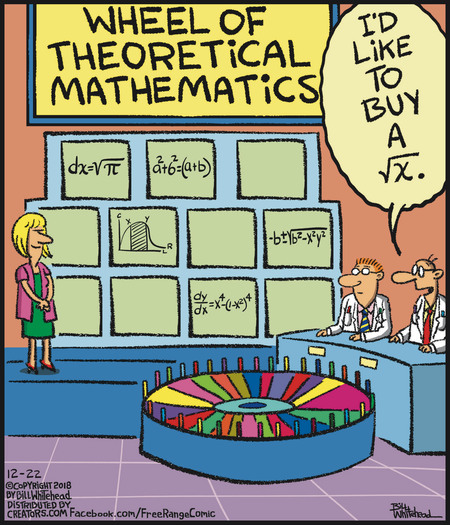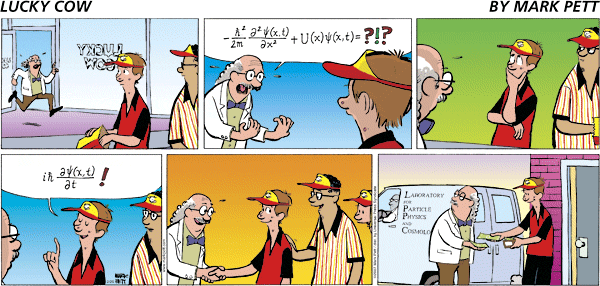There were just enough mathematically-themed comic strips last week for me to make two posts out of it. This current week? Is looking much slower, at least as of Wednesday night. But that’s a problem for me to worry about on Sunday.
Eric the Circle for the 20th, this one by Griffinetsabine, mentions a couple of shapes. That’s enough for me, at least on a slow comics week. There is a fictional tradition of X marking the spot. It can be particularly credited to Robert Louis Stevenson’s Treasure Island. Any symbol could be used to note a special place on maps, certainly. Many maps are loaded with a host of different symbols to convey different information. Circles and crosses have the advantage of being easy to draw and difficult to confuse for one another. Squares, triangles, and stars are good too.

Bill Whitehead’s Free Range for the 22nd spoofs Wheel of Fortune with “theoretical mathematics”. Making a game out of filling in parts of a mathematical expression isn’t ridiculous, although it is rather niche. I don’t see how the revealed string of mathematical expressions build to a coherent piece, but perhaps a few further pieces would help.

The parts shown are all legitimate enough expressions. Well, like is only true for some specific numbers ‘a’ and ‘b’, but you can find solutions.
is just an expression, not picking out any particular values of ‘b’ or ‘x’ or ‘y’ as interesting. But in conjunction with
or other expressions there might be something useful. On the second row is a graph, highlighting a region underneath a curve (and above the x-axis) between two vertical lines. This is often the sort of thing looked at in calculus. It also turns up in probability, as the area under a curve like this can show the chance that an experiment will turn up something in a range of values. And
is a straightforward differential equation. Its solution is a family of similar-looking polynomials.

Mark Pett’s Lucky Cow for the 22nd has run before. I’ve even made it the title strip for a Reading the Comics post back in 2014. So it’s probably time to drop this from my regular Reading the Comics reporting. The physicists comes running in with the left half of the time-dependent Schrödinger Equation. This is all over quantum mechanics. In this form, quantum mechanics contains information about how a system behaves by putting it into a function named . Its value depends on space (‘x’). It can also depend on time (‘t’). The physicists pretends to not be able to complete this. Neil arranges to give the answer.
Schrödinger’s Equation looks very much like a diffusion problem. Normal diffusion problems don’t have that which appears in the part of Neil’s answer. But this form of equation turns up a lot. If you have something that acts like a fluid — and heat counts — then a diffusion problem is likely important in understanding it.
And, yes, the setup reminds me of a mathematical joke that I only encounter in lists of mathematics jokes. That one I told the last time this strip came up in the rotation. You might chuckle, or at least be convinced that it is a correctly formed joke.
Each of the Reading the Comics posts should all be at this link. And I have finished the alphabet in my Fall 2018 Mathematics A To Z glossary. There should be a few postscript thoughts to come this week, though.